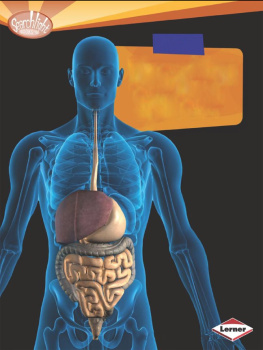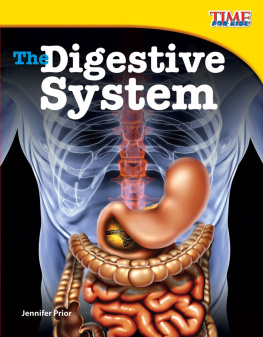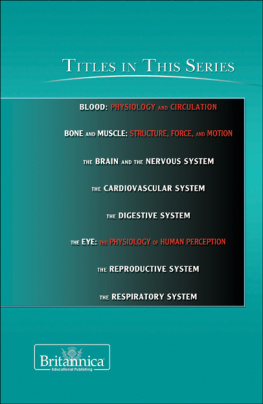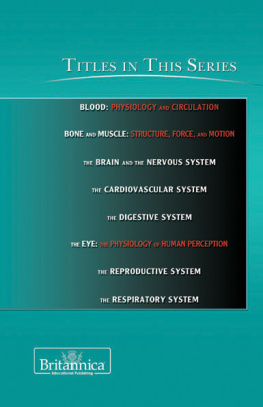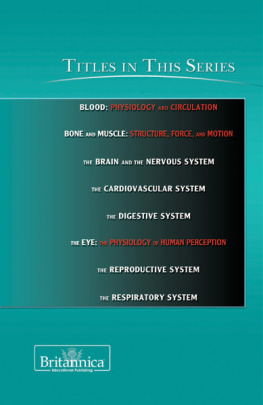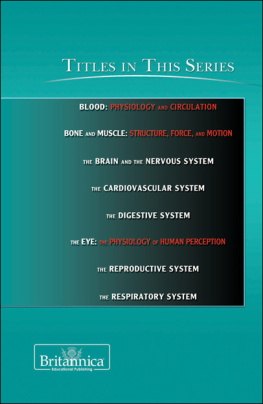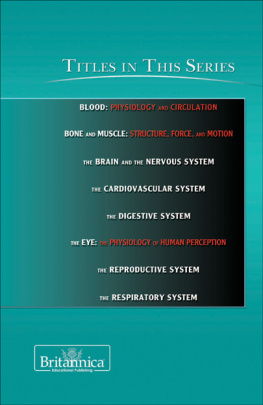THE DIGESTIVE SYSTEM
THE HUMAN BODY
THE
DIGESTIVE
SYSTEM
EDITED BY KARA ROGERS, SENIOR EDITOR, BIOMEDICAL SCIENCES

Published in 2011 by Britannica Educational Publishing (a trademark of Encyclopdia Britannica, Inc.) in association with Rosen Educational Services, LLC 29 East 21st Street, New York, NY 10010.
Copyright 2011 Encyclopdia Britannica, Inc. Britannica, Encyclopdia Britannica, and the Thistle logo are registered trademarks of Encyclopdia Britannica, Inc. All rights reserved.
Rosen Educational Services materials copyright 2011 Rosen Educational Services, LLC. All rights reserved.
Distributed exclusively by Rosen Educational Services.
For a listing of additional Britannica Educational Publishing titles, call toll free (800) 237-9932.
First Edition
Britannica Educational Publishing
Michael I. Levy: Executive Editor
J.E. Luebering: Senior Manager
Marilyn L. Barton: Senior Coordinator, Production Control
Steven Bosco: Director, Editorial Technologies
Lisa S. Braucher: Senior Producer and Data Editor
Yvette Charboneau: Senior Copy Editor
Kathy Nakamura: Manager, Media Acquisition
Kara Rogers: Senior Editor, Biomedical Sciences
Rosen Educational Services
Alexandra Hanson-Harding: Editor
Nelson S: Art Director
Cindy Reiman: Photography Manager
Matthew Cauli: Designer, Cover Design
Introduction by Catherine Vanderhoof
Library of Congress Cataloging-in-Publication Data
The digestive system / edited by Kara Rogers, senior editor.1st ed.
p. cm.(The human body)
In association with Britannica Educational Publishing, Rosen Educational Services.
Includes bibliographical references and index.
ISBN 978-1-61530-252-9 (eBook)
1. Digestive organs. 2. Digestion. I. Rogers, Kara.
QP145.D54 2011
612.3dc22
2010001615
Cover, pp. www.istockphoto.com/Sebastian Kaulitzki
On page : The human digestive system. Mittermeier/Taxi/Getty Images
CONTENTS













H umans eat for many different reasons: because they are hungry, because they are bored, because they are stressed, or simply because the food smells and tastes good. The biological reason for eating, however, is to replenish nutrients and to provide energy to support the bodys functions. The task of the digestive system is to break down food into the elements that the body can use and to eliminate as waste whatever is left over.
One might believe that such a basic function would be well understood, with little left to learn. In fact, scientists are constantly discovering new things about how the digestive system does its job and how it interacts with other aspects of the body. Current research may help experts understand elements of health as diverse as how the digestive system affects immunity as well as its relationship to such important health concerns as heart disease, diabetes, and cancer. This book explores what happens to food in its journey through your body.
The entrance to the digestive tract is the mouth. Although little digestion of food actually takes place in the mouth, it contains important structures that aid in and begin the digestive process. These include the teeth, the tongue, and the salivary glands, which together reduce food into small particles and mix it with saliva in order to speed its progression through the digestive system. Human teeth are specifically designed for an omnivorous diet, with different shapes and surfaces for cutting and tearing meat and grinding grains and vegetables. The muscular tongue moves food around the mouth, pushing it toward the esophagus. The tongue is also covered with a mucous membrane, which contains taste buds, allowing humans to distinguish between different flavours, such as sweet, salty, sour, bitter, and umami (meaty). Saliva, which is secreted by the salivary glands, both moistens food and starts to dissolve it through the action of the enzyme amylase. The salivary glands make saliva to keep the mouth moist, but their action increases whenever chewing occurs. Salivary glands also increase their output in reaction to a stimulus that has been associated with food in the past, such as succulent odours or even a specific sight or sound related to food. So, in fact, peoples mouths actually do water when expecting something tasty such as a sizzling grilled steak.
From the mouth, food passes through the esophagus, driven by the swallowing process. Swallowing is basically involuntaryonce food reaches the back of the mouth the reflex to swallow takes over and cannot be retracted. Muscles in the esophagus then carry food to the stomach through a series of rhythmic contractions known as peristaltic waves. These waves continuously push the food down to the stomach. Amazingly, it takes only 10 seconds for food to move through the esophagus. When people eat in an upright position, liquids simply fall to the bottom of the esophagus and wait for the action of peristalsis to open the lower esophageal sphincter to allow their passage into the stomach.
The stomach is where the process of digestion begins in earnest. The stomach walls contain both a layer known as the gastric mucosa, which secretes gastric acid to dissolve food, and a layer of muscles, which contract to mix food and squeeze it through to the small intestine. Very few nutrients are actually absorbed into the body directly from the stomach, although it can absorb simple sugars. Liquids also pass easily between the stomach lining and the blood. Once the stomach has finished mashing and dissolving the food with digestive juices, the food exists as a semiliquid substance called chyme. At that point the duodenal bulb, where the stomach attaches to the small intestine, relaxes and opens, allowing the stomach contents to progress on the next phase of their journey.
Next page








